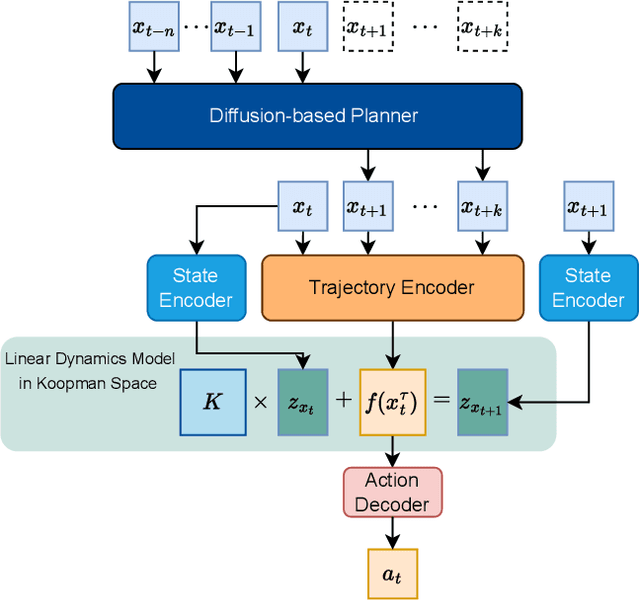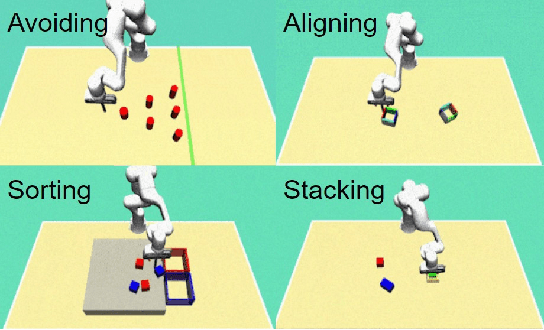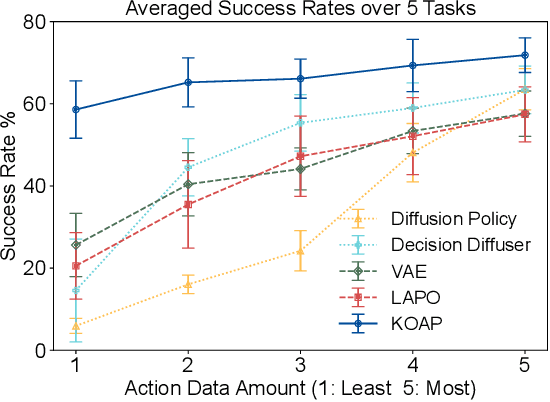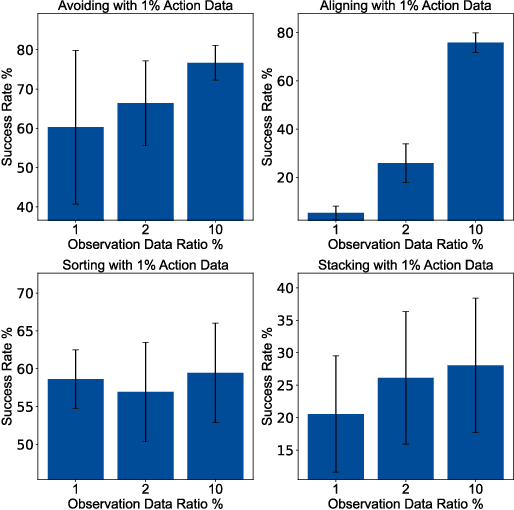Harold Soh
VLA-Touch: Enhancing Vision-Language-Action Models with Dual-Level Tactile Feedback
Jul 23, 2025Abstract:Tactile feedback is generally recognized to be crucial for effective interaction with the physical world. However, state-of-the-art Vision-Language-Action (VLA) models lack the ability to interpret and use tactile signals, limiting their effectiveness in contact-rich tasks. Incorporating tactile feedback into these systems is challenging due to the absence of large multi-modal datasets. We present VLA-Touch, an approach that enhances generalist robot policies with tactile sensing \emph{without fine-tuning} the base VLA. Our method introduces two key innovations: (1) a pipeline that leverages a pretrained tactile-language model that provides semantic tactile feedback for high-level task planning, and (2) a diffusion-based controller that refines VLA-generated actions with tactile signals for contact-rich manipulation. Through real-world experiments, we demonstrate that our dual-level integration of tactile feedback improves task planning efficiency while enhancing execution precision. Code is open-sourced at \href{https://github.com/jxbi1010/VLA-Touch}{this URL}.
FG 2025 TrustFAA: the First Workshop on Towards Trustworthy Facial Affect Analysis: Advancing Insights of Fairness, Explainability, and Safety (TrustFAA)
Jun 05, 2025Abstract:With the increasing prevalence and deployment of Emotion AI-powered facial affect analysis (FAA) tools, concerns about the trustworthiness of these systems have become more prominent. This first workshop on "Towards Trustworthy Facial Affect Analysis: Advancing Insights of Fairness, Explainability, and Safety (TrustFAA)" aims to bring together researchers who are investigating different challenges in relation to trustworthiness-such as interpretability, uncertainty, biases, and privacy-across various facial affect analysis tasks, including macro/ micro-expression recognition, facial action unit detection, other corresponding applications such as pain and depression detection, as well as human-robot interaction and collaboration. In alignment with FG2025's emphasis on ethics, as demonstrated by the inclusion of an Ethical Impact Statement requirement for this year's submissions, this workshop supports FG2025's efforts by encouraging research, discussion and dialogue on trustworthy FAA.
Know When to Abstain: Optimal Selective Classification with Likelihood Ratios
May 21, 2025Abstract:Selective classification enhances the reliability of predictive models by allowing them to abstain from making uncertain predictions. In this work, we revisit the design of optimal selection functions through the lens of the Neyman--Pearson lemma, a classical result in statistics that characterizes the optimal rejection rule as a likelihood ratio test. We show that this perspective not only unifies the behavior of several post-hoc selection baselines, but also motivates new approaches to selective classification which we propose here. A central focus of our work is the setting of covariate shift, where the input distribution at test time differs from that at training. This realistic and challenging scenario remains relatively underexplored in the context of selective classification. We evaluate our proposed methods across a range of vision and language tasks, including both supervised learning and vision-language models. Our experiments demonstrate that our Neyman--Pearson-informed methods consistently outperform existing baselines, indicating that likelihood ratio-based selection offers a robust mechanism for improving selective classification under covariate shifts. Our code is publicly available at https://github.com/clear-nus/sc-likelihood-ratios.
CHD: Coupled Hierarchical Diffusion for Long-Horizon Tasks
May 13, 2025Abstract:Diffusion-based planners have shown strong performance in short-horizon tasks but often fail in complex, long-horizon settings. We trace the failure to loose coupling between high-level (HL) sub-goal selection and low-level (LL) trajectory generation, which leads to incoherent plans and degraded performance. We propose Coupled Hierarchical Diffusion (CHD), a framework that models HL sub-goals and LL trajectories jointly within a unified diffusion process. A shared classifier passes LL feedback upstream so that sub-goals self-correct while sampling proceeds. This tight HL-LL coupling improves trajectory coherence and enables scalable long-horizon diffusion planning. Experiments across maze navigation, tabletop manipulation, and household environments show that CHD consistently outperforms both flat and hierarchical diffusion baselines. Our website is: https://sites.google.com/view/chd2025/home
SocRATES: Towards Automated Scenario-based Testing of Social Navigation Algorithms
Dec 27, 2024Abstract:Current social navigation methods and benchmarks primarily focus on proxemics and task efficiency. While these factors are important, qualitative aspects such as perceptions of a robot's social competence are equally crucial for successful adoption and integration into human environments. We propose a more comprehensive evaluation of social navigation through scenario-based testing, where specific human-robot interaction scenarios can reveal key robot behaviors. However, creating such scenarios is often labor-intensive and complex. In this work, we address this challenge by introducing a pipeline that automates the generation of context-, and location-appropriate social navigation scenarios, ready for simulation. Our pipeline transforms simple scenario metadata into detailed textual scenarios, infers pedestrian and robot trajectories, and simulates pedestrian behaviors, which enables more controlled evaluation. We leverage the social reasoning and code-generation capabilities of Large Language Models (LLMs) to streamline scenario generation and translation. Our experiments show that our pipeline produces realistic scenarios and significantly improves scenario translation over naive LLM prompting. Additionally, we present initial feedback from a usability study with social navigation experts and a case-study demonstrating a scenario-based evaluation of three navigation algorithms.
NUSense: Robust Soft Optical Tactile Sensor
Oct 30, 2024Abstract:While most tactile sensors rely on measuring pressure, insights from continuum mechanics suggest that measuring shear strain provides critical information for tactile sensing. In this work, we introduce an optical tactile sensing principle based on shear strain detection. A silicone rubber layer, dyed with color inks, is used to quantify the shear magnitude of the sensing layer. This principle was validated using the NUSense camera-based tactile sensor. The wide-angle camera captures the elongation of the soft pad under mechanical load, a phenomenon attributed to the Poisson effect. The physical and optical properties of the inked pad are essential and should ideally remain stable over time. We tested the robustness of the sensor by subjecting the outermost layer to multiple load cycles using a robot arm. Additionally, we discussed potential applications of this sensor in force sensing and contact localization.
Imitation Learning with Limited Actions via Diffusion Planners and Deep Koopman Controllers
Oct 10, 2024



Abstract:Recent advances in diffusion-based robot policies have demonstrated significant potential in imitating multi-modal behaviors. However, these approaches typically require large quantities of demonstration data paired with corresponding robot action labels, creating a substantial data collection burden. In this work, we propose a plan-then-control framework aimed at improving the action-data efficiency of inverse dynamics controllers by leveraging observational demonstration data. Specifically, we adopt a Deep Koopman Operator framework to model the dynamical system and utilize observation-only trajectories to learn a latent action representation. This latent representation can then be effectively mapped to real high-dimensional continuous actions using a linear action decoder, requiring minimal action-labeled data. Through experiments on simulated robot manipulation tasks and a real robot experiment with multi-modal expert demonstrations, we demonstrate that our approach significantly enhances action-data efficiency and achieves high task success rates with limited action data.
Stochastic Bandits for Egalitarian Assignment
Oct 08, 2024



Abstract:We study EgalMAB, an egalitarian assignment problem in the context of stochastic multi-armed bandits. In EgalMAB, an agent is tasked with assigning a set of users to arms. At each time step, the agent must assign exactly one arm to each user such that no two users are assigned to the same arm. Subsequently, each user obtains a reward drawn from the unknown reward distribution associated with its assigned arm. The agent's objective is to maximize the minimum expected cumulative reward among all users over a fixed horizon. This problem has applications in areas such as fairness in job and resource allocations, among others. We design and analyze a UCB-based policy EgalUCB and establish upper bounds on the cumulative regret. In complement, we establish an almost-matching policy-independent impossibility result.
Diffusion Meets Options: Hierarchical Generative Skill Composition for Temporally-Extended Tasks
Oct 03, 2024



Abstract:Safe and successful deployment of robots requires not only the ability to generate complex plans but also the capacity to frequently replan and correct execution errors. This paper addresses the challenge of long-horizon trajectory planning under temporally extended objectives in a receding horizon manner. To this end, we propose DOPPLER, a data-driven hierarchical framework that generates and updates plans based on instruction specified by linear temporal logic (LTL). Our method decomposes temporal tasks into chain of options with hierarchical reinforcement learning from offline non-expert datasets. It leverages diffusion models to generate options with low-level actions. We devise a determinantal-guided posterior sampling technique during batch generation, which improves the speed and diversity of diffusion generated options, leading to more efficient querying. Experiments on robot navigation and manipulation tasks demonstrate that DOPPLER can generate sequences of trajectories that progressively satisfy the specified formulae for obstacle avoidance and sequential visitation. Demonstration videos are available online at: https://philiptheother.github.io/doppler/.
Language-Guided Manipulation with Diffusion Policies and Constrained Inpainting
Jun 14, 2024



Abstract:Diffusion policies have demonstrated robust performance in generative modeling, prompting their application in robotic manipulation controlled via language descriptions. In this paper, we introduce a zero-shot, open-vocabulary diffusion policy method for robot manipulation. Using Vision-Language Models (VLMs), our method transforms linguistic task descriptions into actionable keyframes in 3D space. These keyframes serve to guide the diffusion process via inpainting. However, naively enforcing the diffusion process to adhere to the generated keyframes is problematic: the keyframes from the VLMs may be incorrect and lead to out-of-distribution (OOD) action sequences where the diffusion model performs poorly. To address these challenges, we develop an inpainting optimization strategy that balances adherence to the keyframes v.s. the training data distribution. Experimental evaluations demonstrate that our approach surpasses the performance of traditional fine-tuned language-conditioned methods in both simulated and real-world settings.
 Add to Chrome
Add to Chrome Add to Firefox
Add to Firefox Add to Edge
Add to Edge